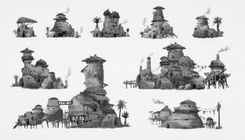Table of Contents
- Why Do I Need a Portfolio?
- 1. Don’t Forget the Most Important Thing - Your Portfolio!
- 2. Quality Over Quantity
- 3. Keep It Focused
- 4. Research the Company
- 5. Show Your Process
What makes a Legendary Concept Art Portfolio? 5 Tips from a Leading Concept Art Outsourcing Studio
We love seeing all of the talented artists in the gaming industry, and we're sharing some essential tips for creating a standout concept art portfolio!
With the recent layoffs in the gaming industry, many artists are busy reviewing their portfolios as much as they can - NDA's we're looking at you! It can be difficult trying to create that perfect concept art portfolio that will hook a recruiter, or you may be feeling lost on how to start.
As a leading concept art outsourcing studio, we’re passionate about supporting talented concept artists in the industry, whether you specialize in environment design, 2D character design, UI/UX or something else entirely we’re sharing some helpful tips and tricks to help you refine your portfolio.
You can watch our portfolio tip video on our YouTube as well!
Why Do I Need a Portfolio?
For any art and design-based role a portfolio is a non-negotiable part of your application, and your portfolio is often the first impression that a studio has of you.
Think of your portfolio like a shop window displaying your skills, passion, and potential to game studios. It offers recruiters a glimpse into how you could fit within their team or on their art projects.
By making sure your portfolio is as great as it can be may feel like a never-ending task - and it is! It requires constant refining and updating to keep competitive in the fast-paced world of game art.

Athena Productions portfolio on ArtStation
1. Don’t Forget the Most Important Thing - Your Portfolio!
It may sound obvious, but you’d be surprised how often applicants forget to include portfolio links, passwords for password-protected websites or PDF attachments. Your first impression on the recruiter shouldn't be that you forgot to send them the most important part of your application - so be sure to check!
If your portfolio includes work protected by NDAs, ensure that your previous clients have approved of you sharing those images. The last thing you want is to get into hot water over confidentiality issues!
💡Be sure to also include your email address on all of your social media accounts, so that clients can get in touch easily!
2. Quality Over Quantity
Remember when we mentioned that your portfolio is like a shop window?
In your 'shop' only the best work should be on display to entice people to hopefully buy - or in this case - hire you. In the competitive world of game art, four top-quality concept art pieces will be more impressive than twenty mediocre ones, but be sure to show enough work that it gives recruiters confidence that your work is consistent each time.

Show only the very best of your work on your portfolio. Work done by our Concept Artist Hunter Catherwood.
3. Keep It Focused
While it’s tempting to include a wide variety of work to appeal to multiple positions, your portfolio should be tailored to the specific role you’re applying for. For example, if you’re aiming for a Character Concept Artist role on a realistic first-person shooter, showcasing pixel art environments will only confuse recruiters.
This doesn’t mean you can’t practice or share work that is usually outside of your wheelhouse, but just be sure to curate your portfolio for the game studios you send out to.
4. Research the Company
Be sure to research the company you are wanting to apply for. Don’t just scatter your portfolio to random companies and hope for the best.
Look into their previous projects, their favoured game art styles (e.g. realistic, stylized), and the level of quality they are hiring at. A great resource to begin your search, is to look at the studios currently employed concept artists on ArtStation. This is especially helpful for entry-level artists just starting their journey to see the level of junior artist portfolios that the studio is hiring.
5. Show Your Process
At Athena Productions, we love seeing the process behind your art. It provides a glimpse into how you tackle tasks and problem solve.
It can be easy to just show a beautiful, polished final image – trust us, we know the struggle! - but seeing your process - from mood boards and sketches, to work-in-progress images, videos and final renders can be incredibly informative for an Art Director or Lead Artist.

The sketching process for some architecture, as shown by our Concept Artist Joris Halgand.
At Athena Productions, we’re always excited to see the incredible talent in the industry. If you’re a concept artist looking to showcase your skills to potential gaming studios, refining your portfolio is the first step to success.
If you’d like to submit your portfolio for consideration, please email it to us at jobs@athena-productions.com.



